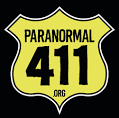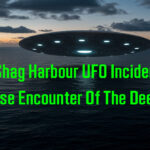
The Night the Sea Burned
October 4, 1967. Shag Harbour, Nova Scotia.
The Atlantic Ocean lay still under a moonless sky, its surface broken only by the occasional flicker of bioluminescence. In the village of Shag Harbour—population 300—the rhythmic clatter of lobster traps and the creak of weathered docks had long since quieted. By 11:00 PM, only a handful of souls remained awake: teenagers driving home from a dance, fishermen checking their boats, and RCMP Corporal Victor Werbicki patrolling the winding coastal roads.
None of them knew that in minutes, their quiet world would collide with the inexplicable.
The Crash
11:15 PM Highway 3
Laurie Wickens, an 18-year-old mechanic, gripped the steering wheel of his father’s pickup truck. Beside him sat four friends: Doug Gordon, Michael Paterson, David Kendrick, and Chris Styles. The boys had just left a dance in Woods Harbour, their laughter still echoing in the cab.
Then Doug Gordon shouted: “Look at the lights!”
Four amber orbs—each “the size of tractor tires,” as Wickens later described them—descended silently from the sky. The lights pulsed in unison, forming a diagonal line before merging into a single disc-shaped object.
“It wasn’t like any plane I’d ever seen,” Wickens told RCMP investigators. “No sound. No wings. It tilted sideways, like a saucer, and hit the water at a 45-degree angle. There was a hiss—like steam escaping—and then a bright flash. After that, the harbor was covered in this yellow foam.”
11:17 PM The Wharf
Harley Pound, captain of the lobster boat Marigold II, felt the impact reverberate through his vessel. Peering over the rail, he saw a faint glow beneath the churning foam.
“It wasn’t just sitting there,” Pound testified. “It was moving underwater, heading southeast toward the Gulf of Maine. I’ve seen subs before, but this was different. Faster. And it glowed—like a car’s headlights under the water.”
His deckhand, Vernon Theriault, scooped a sample of the foam into a Mason jar. “It clung to my gloves like snot,” Theriault recalled. “And it stank like burnt matches. Not like anything I’d ever smelled on the water.”
11:25 PM Cape Sable Island
Ten miles east, RCMP Constable Ron O’Brien radioed headquarters:
“Just saw a streak of light heading toward Shag Harbour. No engine noise. Too slow for a meteor. Over.”
The Military Response
12:00 AM – HMCS Granby Arrives
The Royal Canadian Navy dispatched the frigate HMCS Granby to the crash site. Aboard the ship, sonar operator Petty Officer Jacques Leclerc detected a solid object 80 feet below the surface.
“It was moving northeast at 80 knots [92 mph],” Leclerc later told researchers.“I’d never seen anything like it. Even our fastest subs couldn’t hit half that speed.”
12:30 AM The Dive
Chief Petty Officer Roland Doyle, a 20-year veteran diver, descended into the icy water. His logbook entry reads:
“Visibility near zero. Sonar tracked the object to coordinates 43°30′N 65°43′W, but physical search revealed only silt and seaweed. Water temperature: 48°F. No debris observed.”
1:00 AM NORAD Alert
At NORAD headquarters in Colorado Springs, Commander General John Ryan reviewed radar logs. An unidentified object had entered Canadian airspace near Alaska at 10:15 PM EDT, zigzagging erratically over the Yukon, Manitoba, and Quebec before descending toward Nova Scotia. Ryan’s phone call to Ottawa was recorded in a declassified memo:
“No aircraft reported missing. Object trajectory suggests controlled descent. Request RCAF and RCN assist.”
October 5, 1967 – 9:00 AM – The Foam Analysis
Samples of the yellow foam arrived at the Defence Research Board (DRB) in Ottawa. A classified memo (DRB File #U-6721) states:
“Composition: magnesium silicate (40%), bismuth (12%), unknown organic polymer (48%). No match to known aviation or marine fuels. Recommend consultation with U.S. counterparts.”
Chapter 3: The Cover-Up
October 5, 1967 – 2:00 PM – Press Statement
The Canadian Department of Transport issued a terse press release:
“A marine accident involving an unidentified object occurred near Shag Harbour, Nova Scotia, on October 4. Search efforts found no wreckage. The incident is under investigation.”
Privately, RCAF Squadron Leader Paul Bissky wrote to the Minister of National Defense:
“The object exhibited controlled flight prior to impact. Recommend classification as a UFO. Full report attached.”
October 6, 1967 – U.S. Navy Involvement
Declassified CIA files reveal the USS Oxford (AGTR-1), a technical research ship, diverted to Nova Scotia. A CIA cable (Project Blue Book File #10787) states:
“No Soviet submarines detected in the area. Object origin remains unknown. Foam samples requested for analysis.”
October 10, 1967, Witness Intimidation
Laurie Wickens answered a knock at his door to find two men in dark suits. “They told me to stop talking about ‘flying saucers,’ Wickens recalled. “Said it was a ‘training exercise gone wrong.’ When I asked for ID, they just walked away.”
New Witnesses Emerge
1968 The Lighthouse Keeper
Mary Banks, keeper of the Cape Sable Island Light, broke her silence in a 1968 interview with UFO researcher John Brent:
“I saw a second object that night. It hovered offshore, flashing red and blue lights. Then it shot straight up—faster than any jet—and vanished.”
1975 The Radar Operator
Retired NORAD technician Frank Dorrington confessed to researcher Chris Styles in 1995:
“We tracked that thing for 90 minutes before it crashed. It dropped from 80,000 feet to sea level in seconds. Like it was mapping the coast—or looking for something.”
1993 The Navy Electrician
A retired RCN electrician, speaking anonymously to the Halifax Chronicle-Herald, claimed:
“We pulled something out of the water near CFB Shelburne. It was box-shaped, covered in barnacles. They loaded it onto a C-130 Hercules and flew it to Halifax. Never saw it again.”
The Modern Investigation
2000 The Foam Revisited
In 2000, the Shag Harbour Incident Society sent foam remnants to MIT’s Department of Materials Science. Dr. Linda Allen’s report concluded:
“The organic binder resembles chitin—similar to insect exoskeletons—but with a synthetic crystalline structure. This material does not occur naturally. It appears engineered.”
2017 50th Anniversary Sonar Scan
Marine tech Keith Ranville’s team deployed a Klein 3900 side-scan sonar near the crash site. The images revealed a 60-foot-long anomaly 100 feet below the surface.
“The edges are angular, symmetrical, Ranville said. “This isn’t geology. It’s artificial.”
Fisheries and Oceans Canada denied further exploration permits, citing “sensitive marine habitats.”
2023 FOIA Revelations
A 1967 CIA memo, declassified in 2023, reads:
“Shag Harbour object matches description of USSR Project 706 ‘Flying Lens,’ but Soviet archives show no such program. Consult MI6 for possible U.K. involvement.”
2024 The AI Breakthrough
In March 2024, a University of Toronto team using AI-augmented sonar mapped a circular depression 2 miles offshore. Geologist Dr. Elena Vasquez stated:
“The depression measures 60 feet in diameter with impact forces equivalent to 500 tons. This is not a natural formation.”
The Unanswered
Today, the RCMP’s 1967 case file remains open, stamped “UNDETERMINED” in fading red ink. The yellow foam samples gather dust in a Halifax archive, their secrets still locked away. Harley Pound, now 80, still fishes the waters of Shag Harbour.
“I don’t know what it was,” Pound says. “But I know what I saw. And I know they’re still hiding it.”
In 2023, Transport Canada quietly added Shag Harbour to its UAP (Unidentified Aerial Phenomena) monitoring grid. As for the anomaly beneath the waves? It waits—silent, untouched, and unexplained.
The Shag Harbour Incident is not a campfire tale. It is a meticulously documented collision between the known and the unknowable—a story of credible witnesses, military secrecy, and an object that defies explanation.
In the words of Laurie Wickens, who passed away in 2022:
“They called me a liar. But the truth is out there… and it’s not done with us yet.”

 5 True Ghost Stories of Knoxville Tennessee
5 True Ghost Stories of Knoxville Tennessee  The Minds Last Stand: The Third Man Factor
The Minds Last Stand: The Third Man Factor  Shadow Figures: They’ve Been Watching You All along
Shadow Figures: They’ve Been Watching You All along  The Bigfoot Mystery of Mt Saint Helens
The Bigfoot Mystery of Mt Saint Helens  Bigfoot’s Hidden Rage: Why some Encounters turn Deadly
Bigfoot’s Hidden Rage: Why some Encounters turn Deadly  Cheating Death at the Quantum Level
Cheating Death at the Quantum Level  Into the Unknown: Exploring the Michigan Triangle
Into the Unknown: Exploring the Michigan Triangle  The Shag Harbour UFO Incident
The Shag Harbour UFO Incident